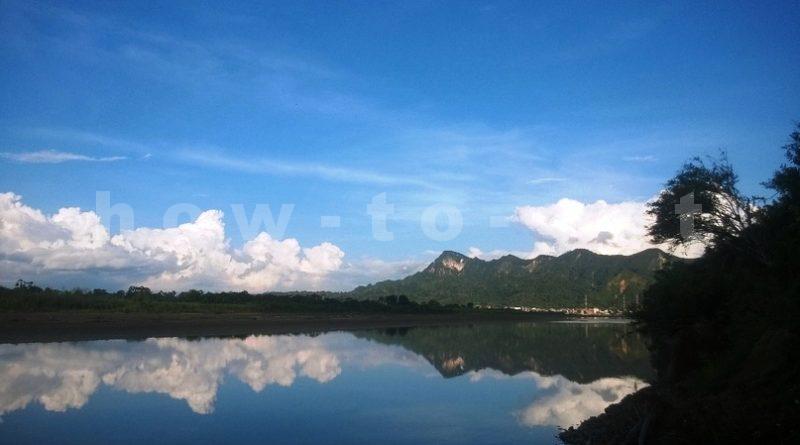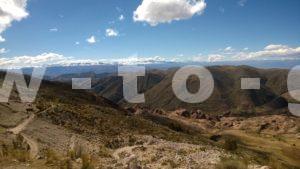Rurrenabaque: buses, pampas and jungle tour
Bolivians go to this tropical city as a resort: to warm up and just relax on the weekends. You betcha! One night on the bus and you’re in a completely different climate region. Tourists are also interested to get into the jungle and pampas, look at pink dolphins and other exotic animals. Regardless of your goals, today we share information with the current prices of 2018 on how to get to Rurrenabak by bus, on the prices of tours to the jungle of pampas, and other details that may be useful to you in an independent trip to Bolivia.
Content:
- How to get from La Paz to Rurrenabaque by bus
- From Coroico to Rurrenabaque
- Transport in the city, bus station and airport
- Rurrenabaque hotels, market, atm
- Jungle tours
- Pampas tours of Santa Rosa
- Attractions and photos of Rurrenabaque
- Schedule of buses from Rurrenabaque to La Paz, Trinidad, Santa Cruz and other cities of Bolivia
__________
How to get from La Paz to Rurrenabaque by bus
You can leave from 4 different places:
-terminal provincial Minasa Yungas-this is not a very large terminal, where the transport goes to the North-Eastern part of the country, and it is located next to the neighborhood Villa El Carmen, which ends avenida de Las Americas and goes to avenida Ramiro Castillo. Buses, minibuses and taxi-collectivo including in Coroico, Chulumani, Coripata, Irupana, Caranavi, Trinidad, etc., etc.
-1 km down (to the center) on avenue de Las Americas, where it intersects with calle Virgen del Carmen, is the point where offices 3 firms also offer flights to Rurrenabaque. From here you can go to Santa Rosa, if you want to live in the jungle (on the photo map below point number 2) ;
— another company in the same quarter on the main Avenue, at the next intersection to the center (with Yanacachi street), where the street market v begins.Fatima; flights at 17: 00 on Wednesdays and Saturdays (on the photo-map point №3) ;
— on calle Yanacachi street, it is also adjacent to avenida de las Americas and calle Ocobaia (on the photo-map point number 4) .
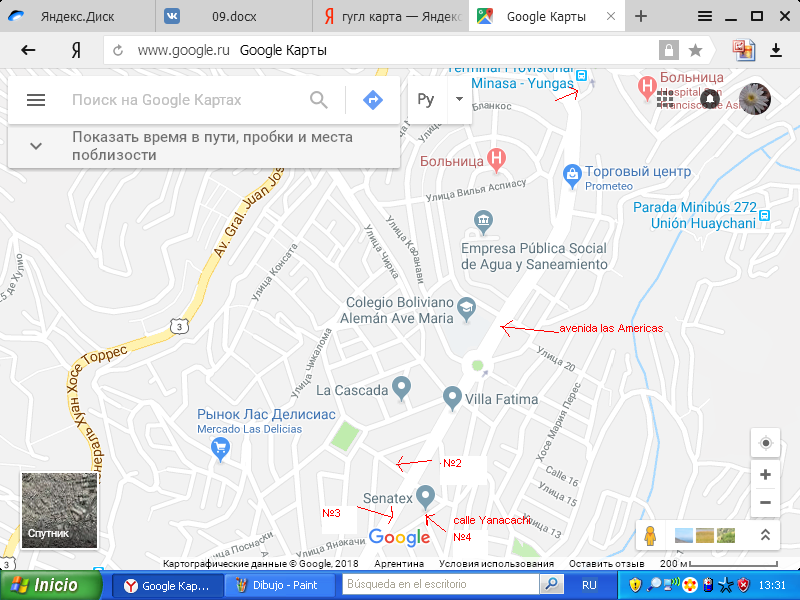
Bus salons in about all companies are the same: semi-cama — C reclining seats. Ticket prices in the range of 60-90 centuries (from $8.6 to $15) as you bargain. Approximate bus schedule in Ruhr (so called local city, which is abbreviated from Rurrenabace): 14:00, 15:00, 16:00 , like there is still a bus at 11 am, but the schedule here no one hangs out: just come and ask at what time of departure. Buses rarely depart on time, a half — hour delay is the norm. There is no need to buy tickets in advance.
To all of the above stations from the center can be reached by minibuses with inscriptions on the windshield V. Fatima, p. Maestro, V. Carmen (fare 2 boliviano), and retro buses-micro #131 and 135 (travel 1.5 BOB).
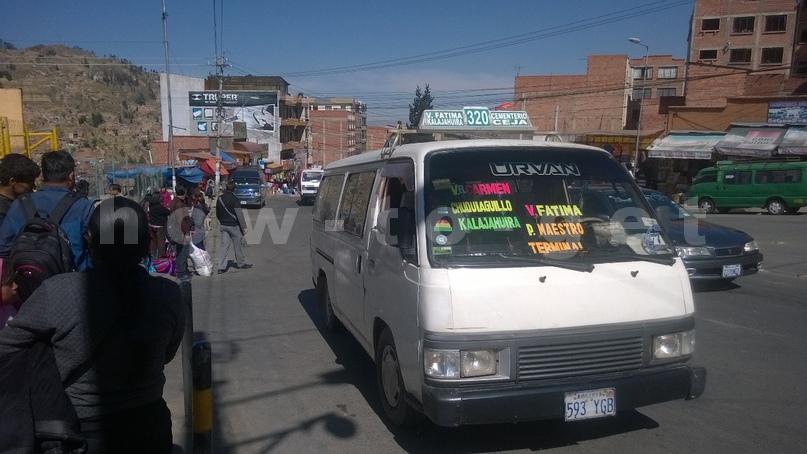

If you want to enjoy stunning views of the mountains: steep cliffs and incredibly beautiful scenery of mountain Bolivia , it is better to take a seat on the bus on the right side, and when you go in the opposite direction from Rurrenabake to La Paz, on the contrary, on the left side of the driver. The bus rises to a height of more than 4.5 km, to the snowy mountains, and then descends to 1.5 km, to the humid tropics. If there is no fog, you can also see the famous Bolivian «road of death».
In total, the journey time is usually 12-15 hours, but it all depends on the time of year. So in the rainy season, which lasts in Bolivia from December to March, when the road is washed away, the driver can go (attention!) right up to the day that you need to take into account and, of course, it is better to take something from food with you in reserve.
There are no toilets inside the buses, but there will be stops along the way. There are no air conditioners either, but if it’s hot, you can open the window, so you should check whether the Windows open and close tightly before you choose and pay for the seats at the ticket seller. You can see what places are free, get on the bus and see what it is. We also recommend to check the seats: they recline or not, as they can be easily broken — the fleet in this direction is usually quite old.
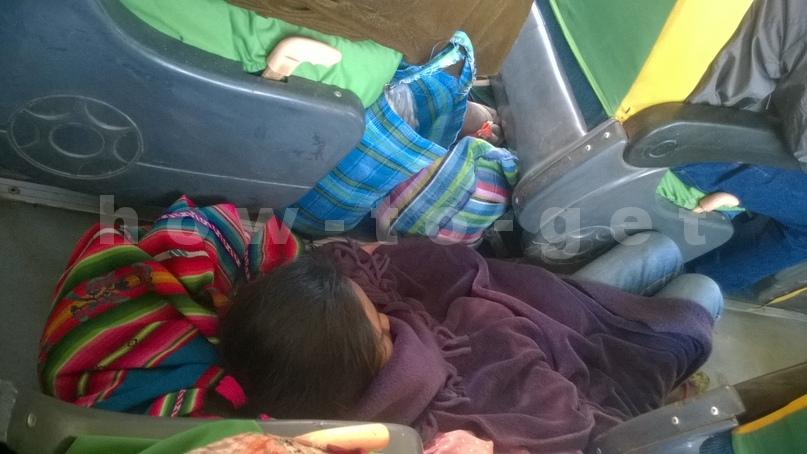
Drivers of this route, on the way from La Paz to Rurrenabak stop 3 times: in the settlements of Yolosita, Caranavi and Yucumo, where you can go to the toilet and buy something from the ready-made inexpensive food, unless of course, you are comfortable with roadside cafes.
Just along the route of buses in Bolivia, as in other Latin American countries, there is a brisk trade in snacks and lemonades, wherever drivers slow down, not to mention stops. It is worth noting that in the old buses, when you go on the primer, which is not a small part of the road, shakes like a tractor, so please be patient.
__________
From Coroico to Rurrenabaque
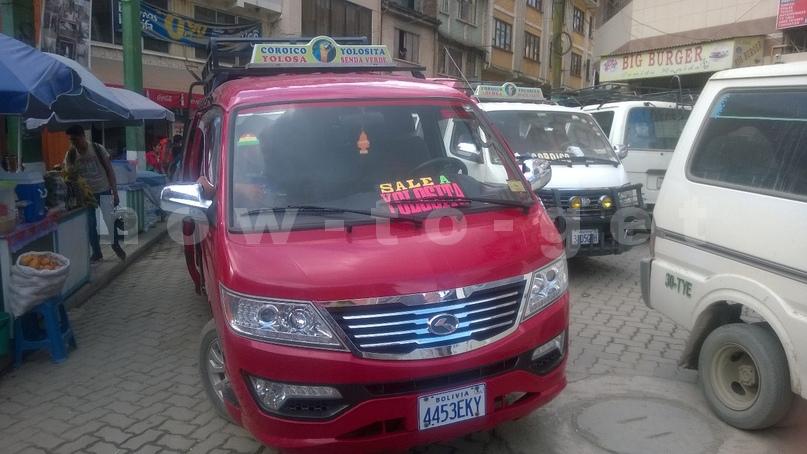
To get to the place where buses stop next to Rurre from La Paz (village of Ialomita), is on the bus-collectivo. The fare is 5 BOB ($0.8). On the bus on top it will be written — Yolosita. Travel time-no more than half an hour. Departure from the morning until the evening (until dusk), approximately every half hour by occupancy.
__________
Transport in the city, bus station and airport
Rurrenabaque itself is quite small, it can all be explored on foot. Local residents use, as a rule, taxi-motorbikes, at a cost of 2 second world war per person, and motor scooters-tuk-tuks, for which usually pay no more than 10 second world war ($1.5) for the whole tuk-tuk (not for the passenger), if you need to go through the whole city, for example to the bus station or to the airport, and if within the Central part — no more than 5 BOB for all passengers (tuk-tuk is designed to transport 2-3 people).
The bus terminal is located 3.5 km from the city centre, in the Eastern part. Near the entrance/exit, as a rule, tuk-tuk and Moto-taxi drivers are waiting for their passengers.

Upon departure from the bus station Rurrenabaque, in addition to the ticket, need to pay terminal fee in 2-3 boliviano. This practice exists in almost all bus stations in Bolivia.
The airport is located on the same street as the bus terminal, just behind the fence from it, and the entrance to the airport is 200 meters from the bus station. To get to the hotel you can walk 200 m to the bass terminal and take a tuk-tuk for 10 boliviano to the city center or take a taxi.
__________
Hotels, atm, market
Housing in the city is not to say that a lot, but in principle enough. Since it is small, you can find accommodation right on the spot. Prices for hotel room with Internet start from 80 centuries a day. For example, hostel «Los Tucanes de Rurre»on the street Bolivar a block from the cemetery (cementerio).
Single budget traveler may be more profitable to stay in a hostel, there are many options with a kitchen from 40 centuries ($5.7) per bed in a dormitory room.
In the village in addition to a huge number of shops and shops there is a grocery market where you can buy products at the standard is not high for Bolivia prices, as well as from Friday evening until Saturday evening the whole promenade turns into a large shopping range.
Mobile service is good. There is one ATM «Banco Union» — at Plaza 2 de Febrero on the corner of Vaca Diez and Comercio. In this kagero (cajero in Spanish) cash withdrawal without a fee.
Jungle tours
You can book your own Lodge and spend a few days in the jungle . It can be reached by a narrow long boat, which is used by Bolivians as a public water transport. The boat (Lancia, as they are called Bolivians), can be rented right on the river. Price depends on the distance of the Lodge from the city, on the way to the driver, whether there will be other passengers or he specifically lucky only you, as well as on the direction, as up the river and the speed is slower and the engine «eats» more fuel against the current.
To move to the opposite shore, in the village of San Buenaventura, local use cargo and passenger ferries (cost 1.5 BOB per person). Now the bridge is under construction, so most likely in the future the water crossing will be abolished.
Directly from the main Ferries pier on the waterfront you can take 1-day trips along the river, to the Madidi Park from 50 boliviano ($7).
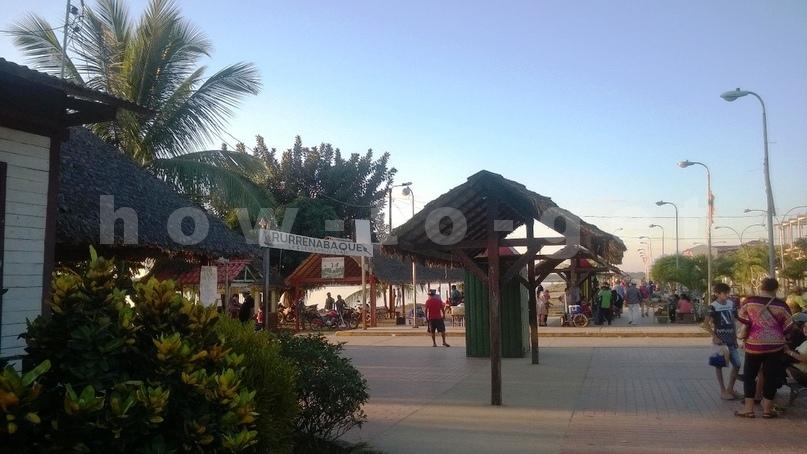
Prices for 3-day tours to the jungle and pampas can range 500-1650 world war II (from USD 72), which is in the heart of Rusape , in Santa Rosa. It all depends on the company that organizes them and the comfort of housing. Usually it is a house with multi-bed rooms for 6-8-10-12 beds. Facilities as a rule, the toilets and showers, and an hour on the street. For the place of Windows, and often walls around the perimeter — mosquito net.
Other tour companies include: Flecha, Bala Tours, Indigena, Dolphin, Mogli, Amazonico, Fluvial. The last 2 are among the most budget.
The entrance to the national Park Madidi, usually charged separately 150 of the second world war ($22). The payment office is down the river after 500 metres. Theoretically, if you hire a driver with a boat, you can arrange that he did not stop, as we had on the Islands of Uros in Peru.
Parque Nacional Madidi is considered to be the most interesting and diverse nature reserve in terms of flora, fauna and climate in Bolivia , and one of the main ecosystems of South America. The number of seen animals and plants depends on luck and mood and professionalism of the guide.
The program of jungle tours is about the same:
Day 1: take tourists from the pier Rurrenabaque by boat and driven across the river to the Lodge; lunch; afternoon jungle walk 4 hours and before sunset, and night after dinner.
Day 2: before lunch walk with excursion to botany and Zoology, after lunch, usually fishing. If you’re lucky, you can catch a piranha. Many animals can be seen only in the dark.
Day 3: offer yourself to make jewelry from natural material for memory, a hike in the jungle .
Usually within a few days, tourists can see birds: toucans and red Amazonian Ares, for example; animals: poisonous and not very snakes, wild boars, monkeys, Howlers; other tropical reptiles: all kinds of termites, beetles, spiders, ants, cockroaches, tarantulas.
__________
Pampas tours of Santa Rosa
Pampas is the geographical name of the steppe, in Bolivia it is noteworthy that it has many flooded areas, forests, creating many narrow channels from which tourists are in great delight.
If the first option is more chosen by lovers of nature and silence, then go to the Pampa to see more animals. To the same, say, tour istov more, and means more noisy and fun.
Initially, we were going to book some Lodge in the jungle on the Internet, where they lure crocodiles, and drive yourself from Rurrenebace in Santa Rosa. But the place was, the buses in this area not only collectivo taxi for 100 bolivianos ($15 ) per person in the road about 2 hours. Direct flights only go from La Paz, as mentioned above.

On day 1, tourists are taken from the Ruhr and driven to Santa Rosa by jeeps, where they are transplanted into boats. There, by the way, right on the pier, if you’re lucky, you can meet pink dolphins. The rest of the program of 3-day tours to Pampa is about the same as in jungle tours only with an emphasis on finding the Caymans and Anaconda.
What animals can be seen in the pump: about the same as in the jungle,only monkeys and birds , they say, many times more, Anaconda, dolphins, with them you can swim at night Cayman.
__________
Attractions of Rurrenabaque
To be honest, we didn’t plan to come here at all. After Peru, we still had a lot of fresh impressions about the canyon Kolka, lake Titicaca, which we visited for free, and in the jungle we already had time to live when we were in Iquitos. So we got here quite spontaneously. We just escaped from La Paz to Rurrenabaque from the cold, which was fed up for the last month! The city itself is nothing special and outstanding of itself is not, but at the same time, it is neat, cute and somehow not in Bolivian clean. On the waterfront and the surrounding streets, as expected, cafes and bars. In General, we liked it here and the week flew by somehow imperceptibly.
One million two hundred thirty four thousand five hundred sixty seven
MonitorIV in the Internet pictures, reviews and prices of Tur in the jungle we decided to abandon this and just relax, but that doesn’t mean that you need to do the same. It all depends on the plans and goals.
In General, all week we just warmed up, walked along the promenade, admired the sunsets, but drank wine.

Once went to the nearby shore of San Buenaventura, where they blew a few fresh orange juices on 1BOB ($0.15), which in the Ruhr are already on 2 and 3 boliviano, and even walked from the city on a mountain forest trail along the river, upstream, in the direction of the canyon Susse (cañon Susse). In fact-a trail through the jungle, light version, walked about 3 km. Periodically from the trail offers magnificent views of the river Beni and the surrounding mountains. And back to the city, estimating time and distance, having no particular desire to return by the same route he came, and that would not return at dusk, just went to the river… and caught the boat! In these parts, it’s all natural. By the way, the first lunch stopped. When landing in it, we immediately indicated the cost to the city. In General, we recommend always specify the full cost (each or both) when boarding, that would not get into trouble at the time of payment.
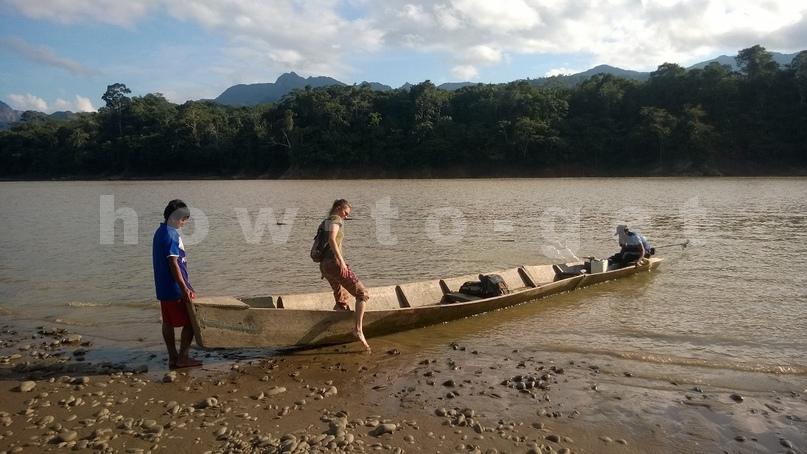
Also from the city you can climb to the observation deck Butterfly Pool el Murador (entrance 2.5 WWII ).
Schedule of buses from Rurrenabaque to La Paz, Trinidad, Santa Cruz and other cities of Bolivia
Many different companies are located at the same bus station. There are day and evening flights To La Paz: 10:30, 11:30, 13:00, 15:30, 17:00,19:00, 19:30.

In Trinidad (Trinidad) you can go by bus for 17-30 hours, 150 WWII ($21). This route passes through the following settlements:
-Okuma (Yucumo);
— San Borja (San Borja) 9-18 hours on the road, 50-80 boliviano (from 7.5 USD);
— San Ignacio (San Ignacio de Moxos) 12 hours, 100 boliviano (from 14 USD). From December to March in Bolivia, the rainy season, and this road can be closed.
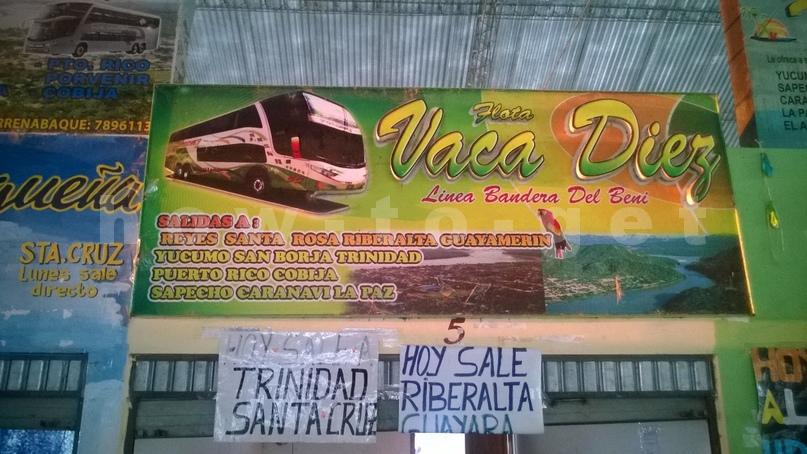
From Coroico to Rurrenabaque, you can go on any bus that go to La Paz, to go to Yolasite (Yolosita) and take a minibus to Coroico. The price of the bus is likely to be the same as to La Paz, though it is 3.5 hours closer, but you can reduce a few hours on the road. Only predict your arrival time and select a flight that would be in Yolasite in the daytime, otherwise you’ll have to catch a taxi or a ride to Coroico.
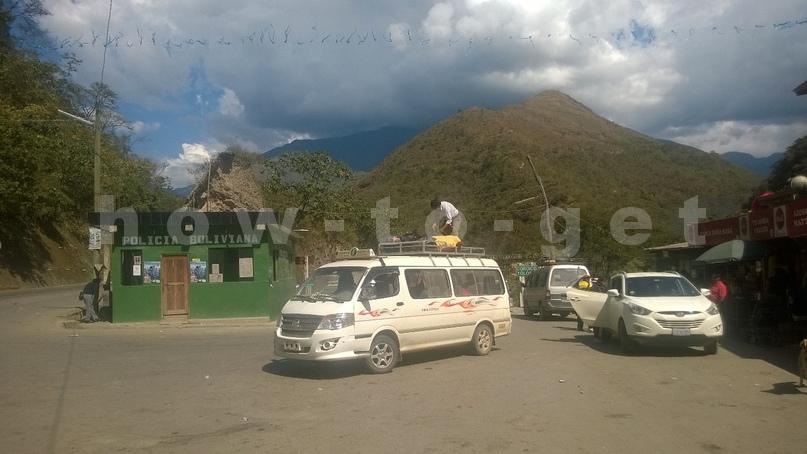
Just saw signs with departure to Santa Cruz (Santa Cruz), Riberalta (Riberalta), Caranavi (Caranavi), Sapeco (Sapecho), Guajara (Guayara), Cobija (Cobija) there is no timetable because it is not permanent.
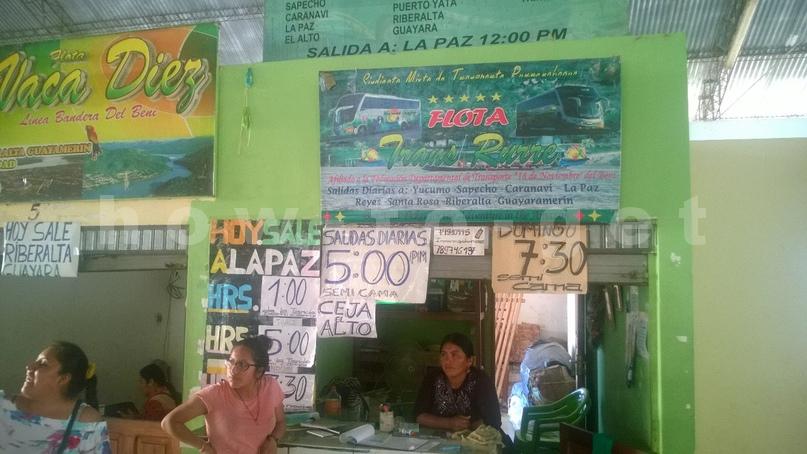
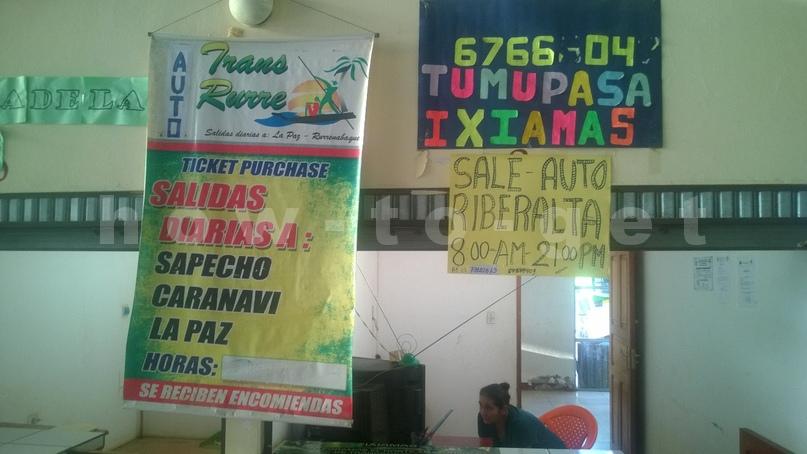
If you have any more questions on buses in Rusape or about tours to the pampas and the jungle of Bolivia, ask in the comments or write to the contacts (see «basement» of the site). And even better connect to us, for sure you have something to share or add to the existing information.
Your faithful travel assistant-
how-to-get command»
4,591 total views, 1 views today

